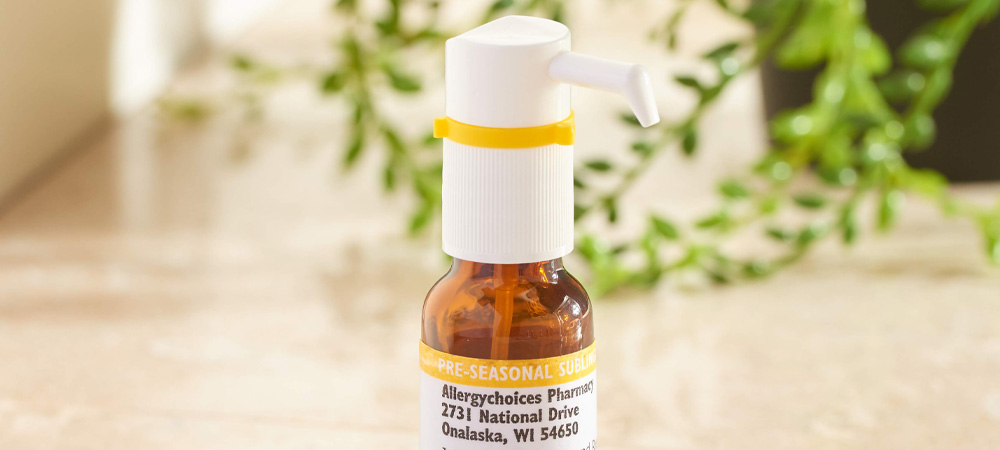Are You Missing Out On This Seasonal Allergy Treatment?

Seasons change… Trees and flowers start budding to form colorful landscapes. Green-leafed trees change into a rainbow of fall colors. Those fall colors turn into a winter wonderland.
Sounds pretty, right? What isn’t pretty — the misery that seasonal allergies often bring.
Even though allergies cause problems year round, a number of environmental allergens “peak” during certain times of the year: trees, grasses, and weeds pollen; dust mites; and mold. This can increase seasonal allergy symptoms — sneezing, itchy/watery eyes, and congestion (you get the picture!).
So, what’s the seasonal allergy treatment you might be missing? Preseasonal allergy drops, or sublingual immunotherapy.
This blog will uncover therapy basics and how it may help you end stubborn pollen, mold, and dust mite symptoms.
What is preseasonal allergy drop treatment?
Preseasonal drops give an extra boost if you’re already taking allergy drops, but still have seasonal symptoms. You take these stronger doses with your regular treatment eight weeks before the problem season starts, so your body is primed and reacts less severely once the pollens peak. But, you have to plan ahead to make it work.
What are the benefits of preseasonal therapy?
You may already be building tolerance to your seasonal allergens as part of your year round personalized allergy drop immunotherapy. Preseasonal therapy provides an extra “boost” and short-term seasonal relief for seasonal allergens to help you get through peak seasons with fewer symptoms. It may even shorten the overall length of your year round immunotherapy treatment.
Which seasonal allergies can preseasonal allergy drops treat?
When you think of seasonal allergies, spring, summer, and fall pollen seasons probably come to mind. But, don’t rule out seasonal allergies during the winter. Mold and dust mites can trigger symptoms all year.
Looking for a guide on upcoming seasonal allergies? Review the seasonal allergy breakdown below to see which allergens typically peak during different times of the year across the U.S.
Spring Allergies (March 1 to May 31)
Tree pollen is a common allergen across the country during the late winter to spring seasons. Grasses and weeds can trigger symptoms as early as April and May in some areas, but are a bigger concern during the summer and fall.
Pollen isn’t the only pesky spring allergen. When the ground begins to thaw in the spring, outdoor mold wakes up. It seems to live everywhere in organic material. Depending on your climate, talk to your provider about when it may be a good idea to start planning ahead and treating for your mold allergy.
Summer Allergies (June 1 to Aug. 31)
Grass and weed pollens increase in June and July. Walnut (black), Cedar (Juniper), and Elm are a few trees that may trigger symptoms during the summer months in some parts of the country, especially in the South.
For those with ragweed allergy, it doesn’t take long to notice when the pollen season begins. It can start as early as July or August and last into October.
Outdoor mold continues to thrive in the summer months, especially if there is repeat rainfall. Popular summer activities, such as gardening, can stir up mold around you and really trigger symptoms.
When mold and ragweed combine, those with allergic asthma often experience what we call the “one-two” punch, battling both allergens at once. Though both allergens can cause problems at the end of summer, the fall is when this combo really becomes a concern.
Fall (Autumn) Allergies (Sept. 1 to Nov. 30)
Grass pollen levels typically decrease by the fall, but Bermuda and Johnson grass pollens often remain higher into August and September. Tree pollens are usually not a major fall allergy concern. Yet, Cedar (Juniper) and Elm can linger from the spring and summer into the fall months.
Most weeds begin to taper off in September. But, dog fennel and notorious ragweed pollen can continue into October across much of the country.
Mold remains a concern during the fall months and can be both an indoor and outdoor problem.
Winter Allergies (Dec. 1 to Feb. 28 or 29)
So, what about the winter months? Cedar (Juniper) and Alder tree pollens may trigger allergies during the winter months, especially in February. Those living in the South Central U.S. may even suffer Cedar (Juniper) symptoms in December — known as “Cedar Fever.” Pine pollen can impact the Southeast beginning in February, which is earlier than in other parts of the country.
Even though you might catch a break from most pollen allergy during the winter months, indoor mold and dust mites are concerns as you spend more time indoors. With homes closed up during the winter months, ventilation issues and humidity buildup allow mold and dust mites to thrive.
Before you know it, high levels of pollen will return and the seasonal allergy cycle will begin all over again.
Who are good candidates for preseasonal allergy drops?
If you’re on allergy drop immunotherapy and battle extra allergy symptoms seasonally, preseasonal treatment might be helpful for you.
Not currently on allergy drop immunotherapy? Preseasonal therapy may help with short-term symptom relief on its own, but it’s best to use preseasonal therapy as an add-on to your year-round treatment for better results. Year-round therapy is what helps your body build long-term tolerance to all of your allergens, including foods.
Get started with personalized allergy drop immunotherapy
Does the thought of ending seasonal allergies bring you a sigh of relief? We can help you find a provider near you who is trained in the La Crosse Method™ Protocol for sublingual immunotherapy so you can start your journey to a happier, healthier life.








